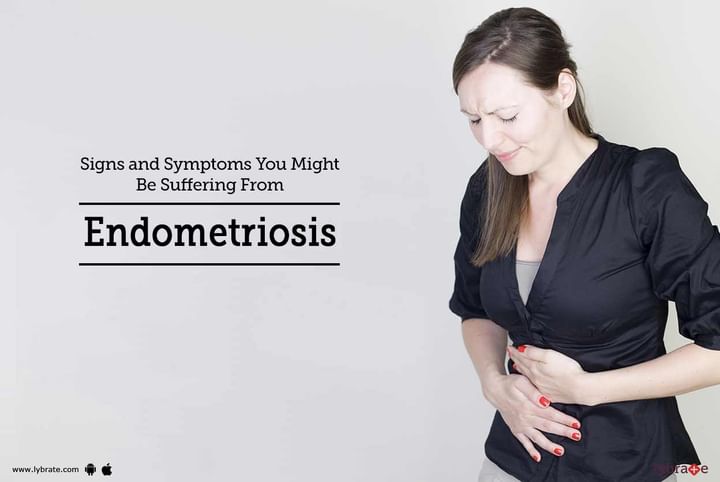Signs and Symptoms You Might Be Suffering From Endometriosis
Endometriosis is an often painful disorder in which tissue that normally lines the inside of your uterus — the endometrium — grows outside your uterus. Endometriosis most commonly involves your ovaries, fallopian tubes and the tissue lining your pelvis. Rarely, endometrial tissue may spread beyond pelvic organs.
With endometriosis, displaced endometrial tissue continues to act as it normally would — it thickens, breaks down and bleeds with each menstrual cycle. Because this displaced tissue has no way to exit your body, it becomes trapped. When endometriosis involves the ovaries, cysts called endometriomas may form. Surrounding tissue can become irritated, eventually developing scar tissue and adhesions — abnormal bands of fibrous tissue that can cause pelvic tissues and organs to stick to each other.
Endometriosis can cause pain — sometimes severe — especially during your period. Fertility problems also may develop. Fortunately, effective treatments are available.
Symptoms
The primary symptom of endometriosis is pelvic pain, often associated with your menstrual period. Although many women experience cramping during their menstrual period, women with endometriosis typically describe menstrual cramp that's far worse than usual. They also tend to report that the pain increases over time.
Common Signs and Symptoms of Endometriosis may include:
-
Painful periods (dysmenorrhea). Pelvic pain and cramping may begin before your period and extend several days into your period. You may also have lower back and abdominal pain.
-
Pain with intercourse. Pain during or after sex is common with endometriosis.
-
Pain with bowel movements or urination. You're most likely to experience these symptoms during your period.
-
Excessive bleeding. You may experience occasional heavy periods (menorrhagia) or bleeding between periods (menometrorrhagia).
-
Infertility. Endometriosis is first diagnosed in some women who are seeking treatment for infertility.
-
Other symptoms. You may also experience fatigue, diarrhea, constipation, bloating or nausea, especially during menstrual periods.
The severity of your pain isn't necessarily a reliable indicator of the extent of the condition. Some women with mild endometriosis have intense pain, while others with advanced endometriosis may have little pain or even no pain at all.
Endometriosis is sometimes mistaken for other conditions that can cause pelvic pain, such as pelvic inflammatory disease (PID) or ovarian cysts. It may be confused with irritable bowel syndrome (IBS), a condition that causes bouts of diarrhea, constipation and abdominal cramping. IBS can accompany endometriosis, which can complicate the diagnosis.
When to see a doctor
See the doctor if you have signs and symptoms that may indicate endometriosis.
Endometriosis can be a challenging condition to manage. An early diagnosis, a multidisciplinary medical team and an understanding of your diagnosis may result in better management of your symptoms.
Causes
Although the exact cause of endometriosis is not certain, possible explanations include:
-
Retrograde menstruation. In retrograde menstruation, menstrual blood containing endometrial cells flows back through the fallopian tubes and into the pelvic cavity instead of out of the body. These displaced endometrial cells stick to the pelvic walls and surfaces of pelvic organs, where they grow and continue to thicken and bleed over the course of each menstrual cycle.
-
Transformation of peritoneal cells. In what's known as the "induction theory," experts propose that hormones or immune factors promote transformation of peritoneal cells — cells that line the inner side of your abdomen — into endometrial cells.
-
Embryonic cell transformation. Hormones such as estrogen may transform embryonic cells — cells in the earliest stages of development — into endometrial cell implants during puberty.
-
Surgical scar implantation. After a surgery, such as a hysterectomy or C-section, endometrial cells may attach to a surgical incision.
-
Endometrial cells transport. The blood vessels or tissue fluid (lymphatic) system may transport endometrial cells to other parts of the body.
-
Immune system disorder. It's possible that a problem with the immune system may make the body unable to recognize and destroy endometrial tissue that's growing outside the uterus.
Risk factors
Several factors place you at greater risk of developing endometriosis, such as:
-
Never giving birth
-
Starting your period at an early age
-
Going through menopause at an older age
-
Short menstrual cycles — for instance, less than 27 days
-
Having higher levels of estrogen in your body or a greater lifetime exposure to estrogen your body produces
-
Low body mass index
-
Alcohol consumption
-
One or more relatives (mother, aunt or sister) with endometriosis
-
Any medical condition that prevents the normal passage of menstrual flow out of the body
-
Uterine abnormalities
Endometriosis usually develops several years after the onset of menstruation (menarche). Signs and symptoms of endometriosis end temporarily with pregnancy and end permanently with menopause, unless you're taking estrogen.
Complications
Infertility
The main complication of endometriosis is impaired fertility. Approximately one-third to one-half of women with endometriosis have difficulty getting pregnant. Endometriosis may obstruct the tube and keep the egg and sperm from uniting. But the condition also seems to affect fertility in less-direct ways, such as damage to the sperm or egg. Inspite of this, many women with mild to moderate endometriosis can still conceive and carry a pregnancy to term. Doctors sometimes advise women with endometriosis not to delay having children because the condition may worsen with time.
Ovarian cancer does occur at higher than expected rates in women with endometriosis. Although rare, another type of cancer — endometriosis-associated adenocarcinoma — can develop later in life in women who have had endometriosis.
Diagnosis: To diagnose endometriosis and other conditions that can cause pelvic pain, the doctor will ask you to describe your symptoms, including the location of your pain and when it occurs.
Tests to check for physical clues of endometriosis include:
-
Pelvic exam. During a pelvic exam, the doctor manually feels (palpates) areas in your pelvis for abnormalities, such as cysts on your reproductive organs or scars behind your uterus. Often it's not possible to feel small areas of endometriosis, unless they've caused a cyst to form.
-
Ultrasound. A transducer, a device that uses high-frequency sound waves to create images of the inside of your body, is either pressed against your abdomen or inserted into your vagina (transvaginal ultrasound). Both types of ultrasound may be done to get the best view of your reproductive organs. Ultrasound imaging won't definitively tell the doctor whether you have endometriosis, but it can identify cysts associated with endometriosis (endometriomas).
-
Laparoscopy. Medical management is usually tried first. But to be certain you have endometriosis, the doctor may advise a surgical procedure called laparoscopy to look inside your abdomen for signs of endometriosis.
While you're under general anesthesia, the doctor makes a tiny incision near your navel and inserts a slender viewing instrument (laparoscope), looking for endometrial tissue outside the uterus. He or she may take samples of tissue (biopsy). Laparoscopy can provide information about the location, extent and size of the endometrial implants to help determine the best treatment options.
Treatment for endometriosis is usually with medications or surgery. The approach you and the doctor choose will depend on the severity of your signs and symptoms and whether you hope to become pregnant.
Generally, doctors recommend trying conservative treatment approaches first, opting for surgery as a last resort.
Pain medications
The doctor may recommend that you take an over-the-counter pain reliever, such as the nonsteroidal anti-inflammatory drugs (NSAIDs) ibuprofen (Advil, Motrin IB, others) or naproxen (Aleve, others), to help ease painful menstrual cramps.
If you find that taking the maximum dose of these medications doesn't provide full relief, you may need to try another approach to manage your signs and symptoms.
Hormone therapy
Supplemental hormones are sometimes effective in reducing or eliminating the pain of endometriosis. The rise and fall of hormones during the menstrual cycle causes endometrial implants to thicken, break down and bleed. Hormone medication may slow endometrial tissue growth and prevent new implants of endometrial tissue.
Hormone therapy isn't a permanent fix for endometriosis. You could experience a return of your symptoms after stopping treatment.
Therapies used to treat endometriosis include:
-
Hormonal contraceptives. Birth control pills, patches and vaginal rings help control the hormones responsible for the buildup of endometrial tissue each month. Most women have lighter and shorter menstrual flow when they're using a hormonal contraceptive. Using hormonal contraceptives — especially continuous cycle regimens — may reduce or eliminate the pain of mild to moderate endometriosis.
-
Gonadotropin-releasing hormone (Gn-RH) agonists and antagonists. These drugs block the production of ovarian-stimulating hormones, lowering estrogen levels and preventing menstruation. This causes endometrial tissue to shrink. Because these drugs create an artificial menopause, taking a low dose of estrogen or progestin along with Gn-RH agonists and antagonists may decrease menopausal side effects, such as hot flashes, vaginal dryness and bone loss. Your periods and the ability to get pregnant return when you stop taking the medication.
-
Progestin therapy. A progestin-only contraceptive, such as an intrauterine device (Mirena), contraceptive implant or contraceptive injection (Depo-Provera), can halt menstrual periods and the growth of endometrial implants, which may relieve endometriosis signs and symptoms.
-
Danazol. This drug suppresses the growth of the endometrium by blocking the production of ovarian-stimulating hormones, preventing menstruation and the symptoms of endometriosis. However, danazol may not be the first choice because it can cause serious side effects and can be harmful to the baby if you become pregnant while taking this medication.
Conservative surgery
If you have endometriosis and are trying to become pregnant, surgery to remove as much endometriosis as possible while preserving your uterus and ovaries (conservative surgery) may increase your chances of success. If you have severe pain from endometriosis, you may also benefit from surgery — however, endometriosis and pain may return.
The doctor may do this procedure laparoscopically or through traditional abdominal surgery in more extensive cases.
Assisted reproductive technologies
Assisted reproductive technologies, such as in vitro fertilization (IVF) to help you become pregnant are sometimes preferable to conservative surgery. Doctors often suggest one of these approaches if conservative surgery doesn't work.
In case you have a concern or query you can always consult an expert & get answers to your questions!



+1.svg)
